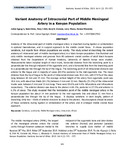Variant anatomy of intracranial part of middle meningeal artery in a Kenyan population

View/
Date
2015Author
Ogeng’o, J
Olabu, B.
Otiti, M. I.
Ominde, B. S
., Mburu, L
Elbusaidy, H
Language
enMetadata
Show full item recordAbstract
Anatomy of the intracranial part of middle meningeal artery is important during ligation or embolization
in epidural haematomas, and in surgical approach to the middle cranial fossa. It shows population
variations, but reports from African populations are scanty. This study aimed at describing the variant
anatomy of intracranial part of middle meningeal artery in a black Kenyan population. One hundred and
sixty middle meningeal arteries and grooves from 80 cadaveric cranial cavities of adult black Kenyans
obtained from the Department of Human Anatomy, University of Nairobi Kenya were studied.
Measurements taken included length of main trunk, horizontal distance from the branching point to a
perpendicular line through midpoint of the zygomatic arch, and a horizontal line from the branching point
to a perpendicular line through the tip of the tragus. The branching point of all intracranial divisions was
anterior to the tragus and in majority of cases (84.9%) posterior to the mid-zygomatic line. The mean
distance from the tip of tragus to the point of intracranial division was 30.6 mm, with 57.9% of the cases
lying between 20 mm and 35 mm. The average vertical height of the artery from zygomatic point was
10.6 mm, with about two thirds (64.1%) between 3 mm and 22 mm. Majority (51.3%) of the intracranial
trunks were between 5 mm and 13 mm long. There were 95.6% and 4.4% bifurcations and trifurcations
respectively. The anterior division was deep to the pterion in 66.3%, posterior in 27.5% and anterior in
6.3% of cases. This study revealed that the termination point of the middle meningeal artery in the
Kenyan population lies about 14 mm posterior to the mid zygomatic line and about 31 mm from a
perpendicular line through the tip of the tragus. It displays variations in stem length, pattern of
branching. Only two – thirds of anterior divisions lie deep to the pterion. Neurosurgeons should be aware
of these variations during ligation or embolization of the artery and in enlarged middle cranial fossa
approach
Citation
Ogeng’o, J., Olabu, B., Otiti, M. I., Ominde, B. S., Mburu, L., & Elbusaidy, H. (2015). Variant Anatomy of Intracranial Part of Middle Meningeal Artery in a Kenyan Population. Anatomy J ournal of Africa. 2015. Vol 4 (2 ) : 571 - 577Publisher
University of Nairobi
